Menu
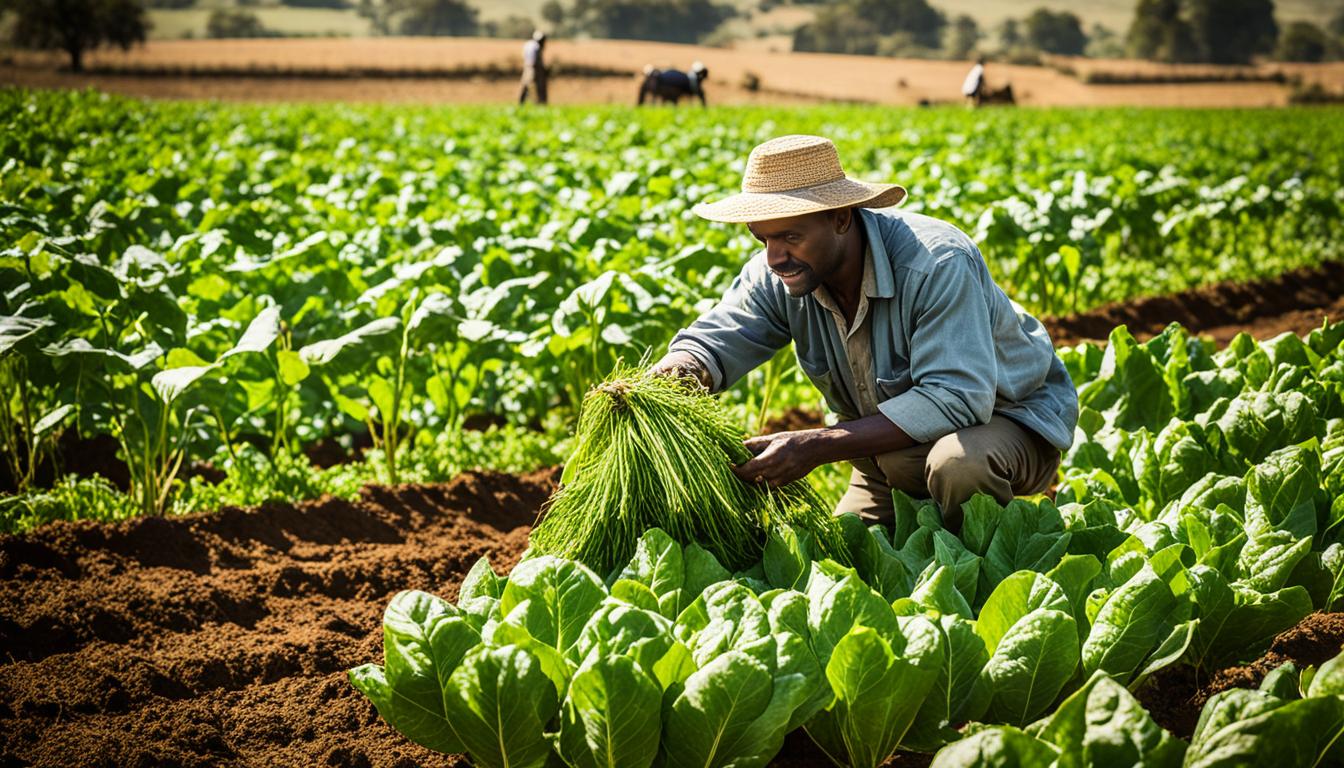
Did you know smallholder farmers make up most of the world’s poor? They play a big part in producing our food. But, they struggle because they can’t get the credit they need. This stops them from buying the tools and supplies they must have for farming. So, it’s hard for them to keep their farms going.
To help these farmers, we need to do a few things. First, they should have easier ways to get money. Second, we should teach them better, more sustainable ways to farm. Finally, we can introduce new technologies like AI to make their work more efficient. It will take a joint effort from governments, NGOs, and businesses to make a real difference.
Smallholder farmers are key to food security worldwide. About 500 million people work on these family farms. They grow important crops like tea, palm oil, and cocoa. But, they face challenges like not having enough money and dealing with large companies. This makes it hard for them to keep farming well over time.
These farmers are the heart of farming, especially in poor countries. In places like Asia and Sub-Saharan Africa, they are most of the farmers. They grow 80% of the food there. Their work is very important for our food supply and fighting climate change.
Despite their hard work, these farmers have many problems to face. They don’t always get the help they need, like loans or advice. Not owning their land on paper also makes it tough to plan for the future. And, there are issues like not treating men and women fairly, health problems, and lacking clean water and toilets.
Economically, things are tough too. Small farmers in Africa, Latin America, and Asia need a lot more money to grow their crops properly. They are short $170 billion in funding. Even though banks lend $50 billion a year, it’s not nearly enough. This gap stops farmers from growing their farms as they’d like.
| Region | Percentage of Farmers | Food Production Contribution |
|---|---|---|
| Asia | 90% | 80% |
| Sub-Saharan Africa | 90% | 80% |
| Latin America | Varied | Significant |
Working together is crucial in helping these farmers. Projects that help them improve and grow new crops are very important. They help fill the gap in support for better and more profitable farming.
Getting financial help for farmers is a big issue worldwide, especially for those who produce most of our food, small-scale farmers. They need money like investment capital and microloans to keep their farms going.
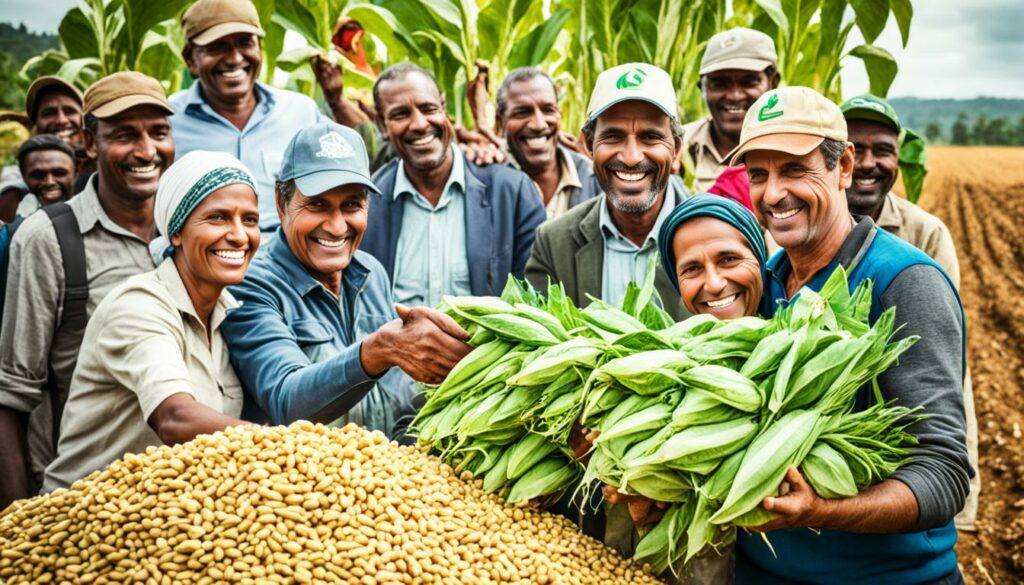
Microloans play a huge role in helping farmers, especially in places without regular banks. These small loans are usually provided by the government or local finance groups. In Asia, state banks often give about $9 billion every year for farmers to borrow.
In places like Latin America and Sub-Saharan Africa, organizations like Root Capital and Oikocredit offer around $3 billion in help. Smaller lenders add up to about $350 million more.
The USDA runs several schemes to help farmers get loans. Programs like the Farm Storage Facility Loan and the Microloan Program support farmers in buying equipment and getting organic certifications. These loans help make farming more eco-friendly and boost how much food is grown.
Each year, small farmers get about $50 billion in loans around the world. But they really need about $170 billion more. This gap must be filled using new ways of lending and getting more banks and groups to join in.
| Region | Formal Financial Sector | Microfinance Institutions | Social Lenders |
|---|---|---|---|
| Asia | $9 billion | Minimal | Minimal |
| Latin America & Sub-Saharan Africa | Minimal | $3 billion | $350 million |
Training and education play a key role in helping small farmers learn about and use sustainable farming methods. Teaching farmers about better farming techniques can boost their harvests. This not only helps them make more money but also improves the health of their soil and crops.
Farmer training programs are specially made to help small farmers tackle their farming problems better. They give farmers the knowledge they need to take care of their land well and grow their crops right. Opportunity International is a great example. They teach farmers the best ways to farm to get more crops and earn more money.
Farmer Support Agents (FSAs) go out to these far-off places and teach farmers about a kind of farming called regenerative farming. They help farmers learn low-cost ways to make the land better. Using digital tools makes these lessons more effective. Farmers end up getting support that fits what they really need and can use.
Regenerative agriculture is at the heart of long-term farming success. This type of farming keeps the soil healthy and the fields productive for many years. It uses methods like planting different crops in a row, not turning the soil much, and covering the soil with plants. These ways help soil hold water better, keep it from blowing away, and invite wildlife back.
Using smart tools that learn can also help small farmers a lot, the training shows. These tools can warn farmers about bad weather or bugs that might hurt their crops. This means farmers can make plans that help them keep farming even when things get tough.
| Training Program | Key Techniques | Benefits |
|---|---|---|
| Opportunity International | Good Agricultural Practices | Increased Yield, Improved Income |
| Farmer Support Agents (FSAs) | Regenerative Agriculture, AI Tools | Enhanced Soil Health, Better Decision-Making |
Government support is also very important for these training programs to work. Governments and groups that help others need to keep giving support and teaching. This way, small farmers have all they need to farm well and help make sure there is enough food for everyone.
Using *agricultural technology* is key for small farms to do better in both production and sustainability. As 12% of people around the world lack enough food, we must employ *software solutions for agriculture* fast. This tech makes farm management easier and helps increase harvests. Small farms make up 84% of all farms and play a big part in feeding the world.
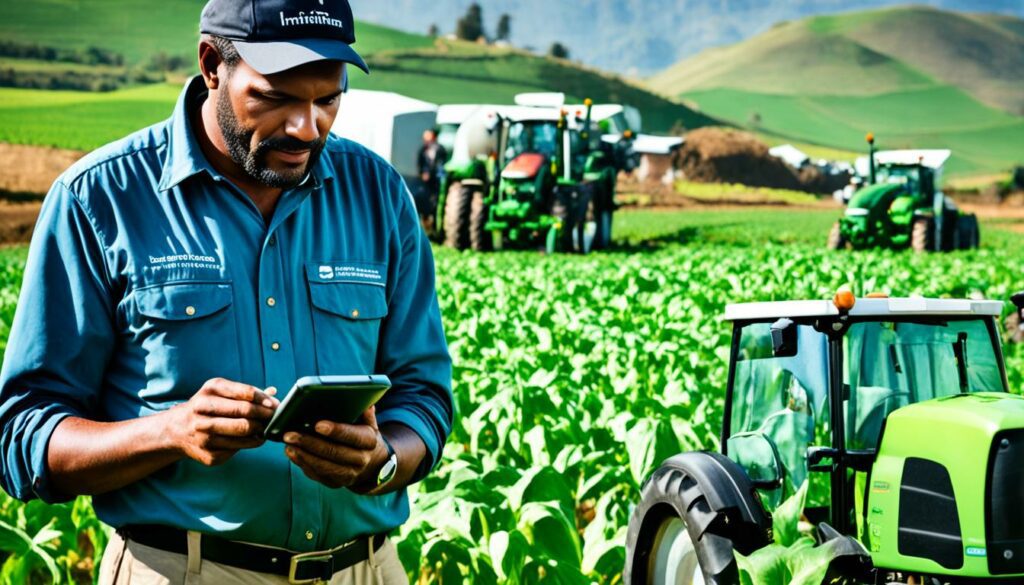
*Software solutions for agriculture* not only help but are easy to use. They let farmers plan farms, deal with land issues, and get advice on what to grow. By the end of 2020, 94% of the world had mobile internet. This means even farmers in places like Sub-Saharan Africa can use this technology.
| Statistic | Impact |
|---|---|
| Mobile broadband coverage | 94% globally, increasing technology access for smallholders |
| Global croplands with 2G network | 84% coverage, supporting digital agricultural solutions |
| Smallholder contribution to food supply | 35% in Sub-Saharan Africa, showcasing potential for tech integration |
AI is changing the game in farming by predicting what markets will need and helping fight pests. It lets small farmers use facts to grow better and greener. Companies like ClimateAi help keep supply chains strong against the harm of climate change. Thanks to these new tools, farmers can deal with weather changes and risks better.
Putting mobile tech together with AI gives farmers quick, important info. Thanks to mobile internet, this help is now available to small farmers everywhere. Going digital not only boosts the farm’s work but links farmers all over, sharing tips and news.
Sustainable farming is vital for both the planet’s health and our future food supply. It centres on regenerative agriculture, aiming to improve the natural balance in farming. Let us explore the benefits of this approach and how it boosts soil health.
Regenerative farming offers many upsides. It focuses on keeping the soil healthy and managing water well to keep farms productive. Efforts by companies like Unilever show how farming with a green focus can value the land and boost plant and animal life.
Working with NGOs is key to making small farms more successful. Krishi Jyoti, for example, has brought better results in farming and saved a lot of water. This not only helps farmers but also the local environment.
Regenerative farming really cares about the soil. By using smart soil methods, we can stop soil loss and make crops healthier. This keeps farms running well into the future, without harming nature. Building check dams has saved a huge amount of water, which helps farming and the local water supply.
Here are some major wins from these green projects:
| Project/Initiative | Outcome |
|---|---|
| Krishi Jyoti Project | 15.59–26.5% increase in crop productivity |
| Water-efficient Irrigation | 291 million litres conserved annually |
| Check Dams | 66.82 million litres water storage capacity annually |
| School Programmes | 7,551 children benefited |
| Kitchen Gardens | 700 gardens in 20 villages |
| Income Increase | 15-20% rise in farmers’ income |
Regenerative farming is good for the environment and the economy. It helps small farmers overcome tough times, like climate change. By choosing to farm sustainably, we ensure a future where people and nature thrive together.
Focusing on rural livelihood support is key to making rural areas thrive. It ensures that farmers can reach training, resources, and financial support.
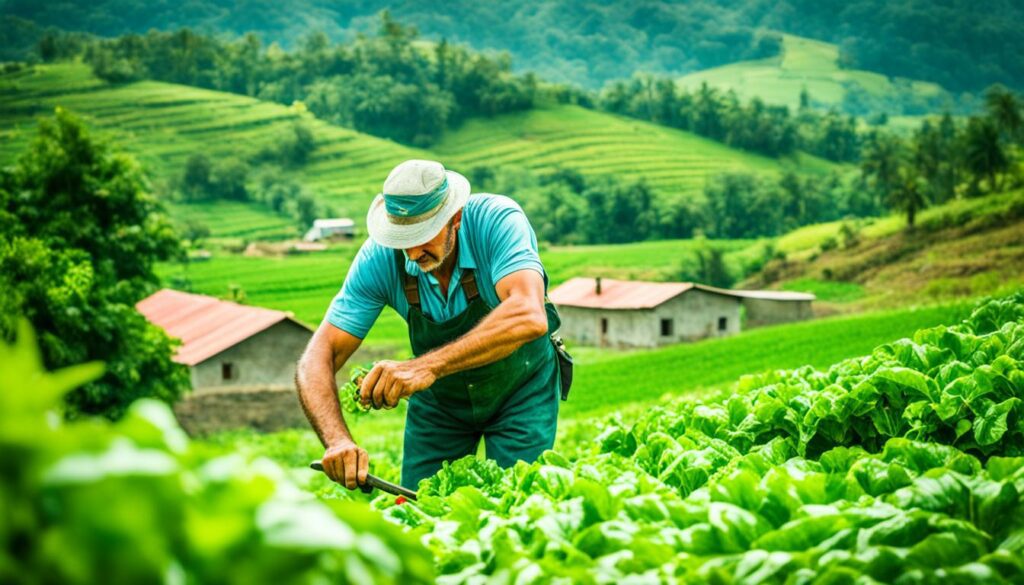
Many farmers now use better farming methods after training. For example, in Sri Lanka, workshops by the Rainforest Alliance have cut costs and improved soil health for nearly 100,000 farmers. And in Indonesia, cocoa farmers are learning green techniques to boost their crops and protect the land.
| Country | Training Programme | Benefits Observed |
|---|---|---|
| Sri Lanka | Rainforest Alliance Workshops | Reduced Costs, Healthier Soils |
| Indonesia | Cocoa Farming Techniques | Improved Yields, Soil Conservation |
Having enough funds is vital for countryside economies to grow. The Rainforest Alliance helps set fair wages in the supply chain, leading to less deforestation and over $5 million a year in wages. Certified farms in places like Ghana see greater earnings and savings, showing the benefits of organised money matters.
Teaching diversification and smart planning helps shield communities from financial shocks. In Kenya, a simple soil test can be cheaper and more effective than just using fertilisers. And in Zambia, careful planning has helped manage money better, especially when food is scarce.
Making country life sustainable calls for small loans and government help for the poorest. This should increase food and job options, and bring together those with and without land to work on various projects.
Supporting practices like multiple crop planting is a must for food security and protecting land rights. Raising awareness in communities, bettering how goods move around, making young people more job-ready, and supporting tribal policies all help keep the countryside strong and exciting.
“Strengthening rural livelihoods through effective strategies and support systems can transform communities, ensuring sustainability and resilience amidst changing economic and environmental landscapes.”
Community empowerment in farming helps smallholder farmers develop and be more productive. It involves working together and learning through various educational projects. This way, farmers can improve their methods and have better lives.
Cooperative farming is vital for small farmers because it gives them more power together. Unilever helps by working directly with farmers, partnering with NGOs, and giving out certifications. They mainly focus on crops like cocoa, palm oil, coconut, and tea to boost local farming.
Around 500 million people globally depend on small farms for their income. These farms produce key products like tea, palm oil, vegetables, and cocoa. But, small farmers often lack training, information, and financial aid. They might not even have the right documents for their land, making their struggles worse.
Education is crucial for supporting small farmers. Programmes teaching about sustainable farming and new, better ways to farm are very helpful. TechnoServe has helped many farmers connect with markets, increasing their income in 2018. Notably, 37% of these farmers were women.
Offering education and market strategies can help solve bigger issues like gender inequality and health problems. It also helps farmers fight against the effects of climate change. They can do things like improve the soil, save water, and reduce carbon in the air.
| Challenges | Community Empowerment Solutions |
|---|---|
| Lack of Access to Training and Information | Educational Initiatives |
| Limited Financial Support | Cooperative Farming Models |
| Gender Inequality, Health Issues | Empowerment Through Education |
| Poor Access to Sanitation | Community Development Programmes |
Smallholders are using new ways to grow crops better. To tackle today’s farming issues, they take on new crop methods and better farm management. These steps can help them grow more crops while keeping the land healthy for the future.
Using new ways to manage crops can lead to better harvests. For example, not tilling the soil (zero tillage) is a big hit in Buxar. Here, 80% of farmers use this method to protect soil, keep water in, and grow more crops. In Rajapur, everyone uses zero tillage and has seen a big jump in wheat crops, from 10-15 to 20-25 quintals an acre.
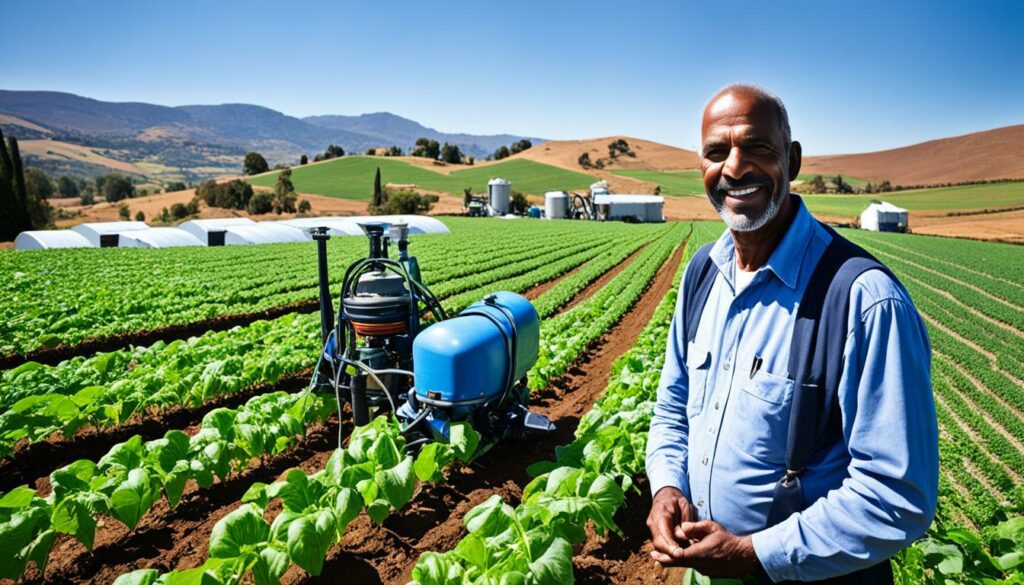
Growing rice without ploughing has also worked well, especially where water is not a problem. The Sustainable Intensification for Smallholders project says this can be huge. They think 32.84 million hectares will use this method widely, compared to 16.30 million hectares using older ways. These new methods make better use of resources and help farms get bigger.
Stopping bugs and diseases is very important. New tech like smart tools and phone apps help farmers fight pests better. This matters a lot, with farming being a big source of greenhouse gases in India, at 14%.
Dealing with pests needs help from many farmers. Teaching them about managing pests better can cut down on crop losses. There’s a big plan to lower harmful emissions a lot by 2050, at 1.36 gigatons for the first plan and half that for the second. This shows that fighting pests in new ways is both good for the earth and makes sense.
| Scenario | Adoption Rate (Million Hectares) | Emissions Reduction (Gigatons CO2 Equivalent by 2050) | Net Profit Per Hectare (USD/Year) | Operational Costs (USD/Hectare Yearly) | Lifetime Net Operational Savings (Billion USD) |
|---|---|---|---|---|---|
| Scenario 1 | 32.84 | 1.36 | 897.63 | 614.23 | 148.35 |
| Scenario 2 | 16.30 | 0.68 | 483.90 | 755.95 | 73.62 |
Government policies are crucial in helping smallholder farmers. They do this by improving their access to markets and by promoting effective land conservation. We will look at two key areas: getting to markets and managing land well, which help farming to last.
One main issue for small farmers is reaching big markets. Good government policies can help by improving roads and connecting farmers to buyers. Small farmers in Sub-Saharan Africa produce most of the food. Making sure their products can be sold widely is very important. For example, the USDA’s National Farmers Market Directory helps over 2 million people find these markets each year, boosting sales. Also, Market News gathers and shares important data on things like beef prices and local farm goods. This makes markets clearer and fairer for farmers.
Looking after the land well is just as important for small farms to last. Policies that focus on using the land in smart ways, like growing different crops and using methods that help the environment, are key. Doing this makes the soil better and farming more sustainable. The USDA helps by funding the building of over 10,000 high tunnels since 2010. This helps with saving the land and getting better crops. Also, the USDA helps small and mid-sized farmers meet Good Agricultural Practice (GAP) standards. This makes their farming more sustainable too.
| Credit Provider | Amount Provided (in billion $) | Region |
|---|---|---|
| Community-Based Organizations | 25 | Global |
| State Banks | 9 | Asia |
| Microfinance Institutions | 3 | Global |
| Social Lenders | 0.35 | Global |
| Commercial Banks | 1 | Global |
Non-governmental organisations (NGOs) are critical in supporting smallholder farmers. They do this through various projects. This includes both direct help for farmers and speaking up for them in policies.
NGOs team up with governments and companies to push for better farming practices. Their goal is to make farming more sustainable. This helps small farmers and the environment too.

NGOs offer lots of help to small farmers. They give them access to credit, teach them better farming, and provide important resources. This type of assistance is key in making sure farmers can use sustainable farming.
Trainings teach about things like improving the soil and reducing damage to it. They also help farmers improve their crops. Giving this knowledge is crucial for farmers to move to better, greener ways of farming.
NGOs also fight for better farming laws. They push for policies that help farmers, like easier ways to get loans or using greener techniques. They make sure governments support small farmers through their rules.
For instance, groups like the Fambidzanai Permaculture Center (FPC) and the Zimbabwe Organic Producers and Processors Association (ZOPPA) work hard in Zimbabwe. They have promoted organic farming a lot, even without much help from laws. Their work shows how important NGOs are in making farming better.
| NGO | Initiative | Impact |
|---|---|---|
| Fambidzanai Permaculture Center (FPC) | Certified Organic Agriculture | Promoted sustainable farming practices and improved yield |
| Zimbabwe Organic Producers and Processors Association (ZOPPA) | Organic Certification Programs | Boosted smallholder market access and income |
Bringing the private sector into agriculture changes the game for small farmers. It ensures they get a fair price for their crops. This boosts their income and helps them stay afloat economically.
Setting fair prices is key for small farmers to run a sustainable business. Projects like the Southern Agricultural Growth Corridor of Tanzania (SAGCOT) focus on this. They make sure farmers get good market prices. For example, in Malawi, a system is in place for sugar farmers. It guarantees them a fair price for their sugar through solid agreements.
The private sector also helps farmers learn and gives them what they need. The Africa Enterprise Challenge Fund (AECF) does this through innovation. For example, the Financial Deepening Trust in Kenya offers key financial services to farmers. These steps have been a success. They’ve helped with pineapple farming in Ghana and with cotton networks in Africa by Dunavant.
Helping farmers get into markets is crucial. The Food Retail Industry Challenge Fund aids African farmers in reaching European shops. This shows how well local farmers and global markets can work together. But, the private sector’s role is wider than just this. It also helps farmers learn to use sustainable methods. An example is the Chiansi project in Zambia. Here, farmers are taught how to use water better for farming.
| SAGCOT | Illovo, Malawi | Blue Skies, Ghana | Dunavant, Africa | AECF |
|---|---|---|---|---|
| Engagement in smallholder farming | Formalised sugar contracting | Innovative support for pineapples | Local distributor networks for cotton | Private sector innovation |
In recent years, farming has faced big challenges from climate change. Small farmers are hit especially hard. They need quick and smart ways to adjust their farming methods, especially in areas where small farms are very important.
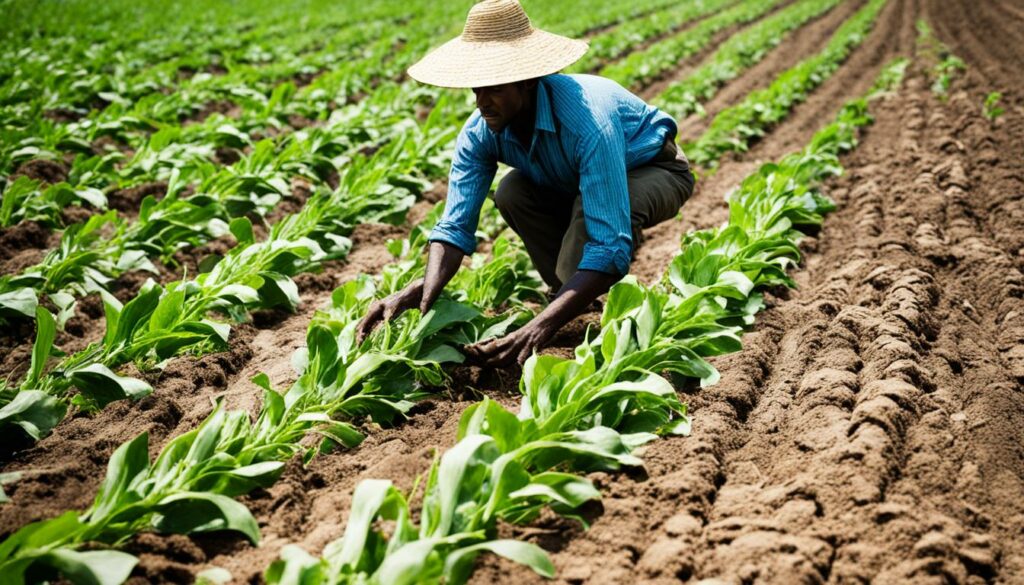
In Zimbabwe, the 1990s saw a dry year every five years. Now, they face drought every two years, sometimes back to back. This shows the urgent need for better farming strategies to deal with these changes. Africa is set to get even hotter than the rest of the world, with temperatures rising 2 degrees between 2025 and 2040. This means growing crops will get harder due to too little water and too much heat. By 2050, nearly all African countries will have very tough conditions. This will affect jobs and the economy.
It’s key to make small farms more able to deal with climate change. In Africa, these farms help the most in reducing poverty, more than other sectors. Supporting these farms well can fight poverty, which events like COVID-19 make worse. They pushed 31 million into extreme poverty. Almost all small farmers see how climate change is affecting them. So, helping them is very urgent.
The Africa Adaptation Acceleration Program plans to gather $25 billion over five years for small farmers. This is a great start. They also want to double the funding for CGIAR, which is really good at creating climate-smart solutions for farmers. Every dollar put in CGIAR brings $10 in benefits, mostly to the farmers themselves.
| Region | Projected Crop Impact | Projected Temperature Increase |
|---|---|---|
| Africa | Severe aridity affecting 70% of crop areas | 2°C by 2025-2040 |
| Zimbabwe | Drought every 2 years | Data not specific |
| Honduras, El Salvador, Nicaragua | 20%-15% reduction in bean and maize production by 2025 | Not projected |
By funding good climate strategies, small farmers can keep being a big help in feeding people and growing the economy, even with the challenges of climate change.
Helping small farmers is not simple. It involves many areas like money, education, and new technology. The goal is to make the help last and really make a difference. Too often, only helping in one way solves the problem for a short time.
Looking closely, methods that cover all farmer needs are better in the long term. These full solutions tackle the many issues farmers face. For instance, farmers doing better financially can buy new technology and improve their work.
But when we just fix one problem, we miss the deeper struggles farmers deal with. Teaching sustainable farming in a rich, learning environment makes it more likely to last. This way, farmers learn and improve their land wisely.
It’s key to think about local culture when supporting farmers. Not doing so could mean the help isn’t taken up well. So, it’s best to mix old farming ways with new helpful ideas.
Farmers learn more when it fits their culture. This also stops unwanted effects and makes sure help goes where it’s really needed. Good plans make sure the community grows stronger together.
| Factor | Holistic Approach | Single Aspect Intervention |
|---|---|---|
| Access to Financial Resources | Higher | Lower |
| Training and Education Rate | Higher | Lower |
| Technology Adoption | Higher | Lower |
| Sustainable Practices Adoption | Higher | Lower |
| Impact on Soil Health | Positive | Moderate |
Bolstering market access helps small farmers find economic opportunities. They link directly to the market and use farm data. This improves how they make decisions and handle their crops.
Having direct market access is key for small farmers to improve financially. The Walmart Foundation gives over $86 million since 2017 for this cause. This money helps connect farmers to markets. More than one million small farmers benefit, with 50% being women.
In India, grants of over $39 million help 800,000 farmers. The PRADAN initiative supports 45,000 women farmers, helping a total of 225,000 people. Creating direct links to the market makes sure farmers get good prices and find new customers.
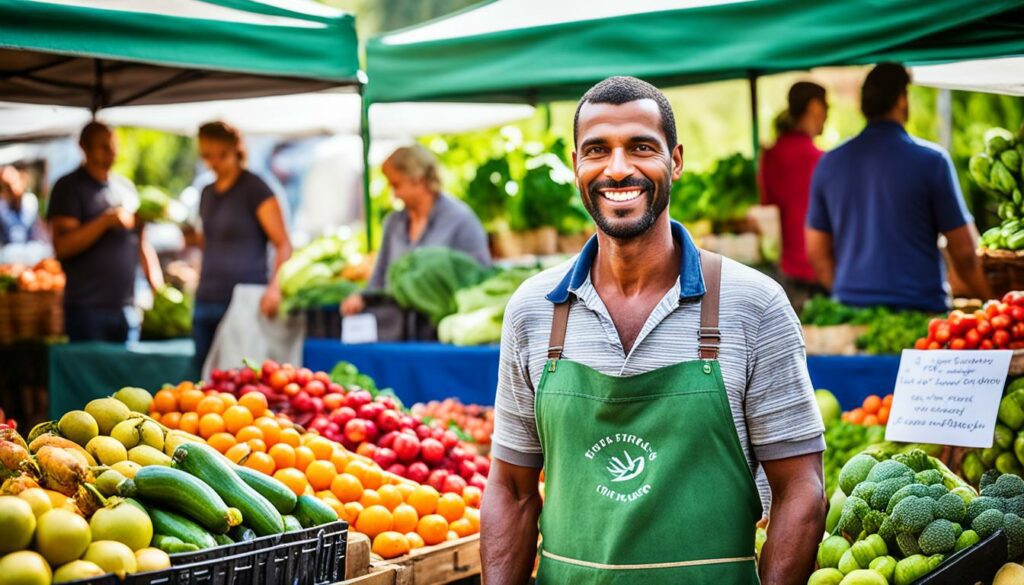
Using farm data is crucial for farming’s economic growth. Tanager’s $2.6 million grant aids 15,000 farmers. It boosts their productivity and profits using smart market strategies. This help focuses on 5,600 women farmers.
The TechnoServe Market Access Program helps 5,000 small farmers in Guatemala and Nicaragua earn more. By studying market trends, farmers can predict demand and improve their crops. This method is used worldwide and has encouraged farmers in 40 countries to move from just getting by to making a living.
| Organisation | Grant Amount | Target Beneficiaries | Key Outcomes |
|---|---|---|---|
| Walmart Foundation | $86 million | 1 million farmers, 50% women | Improved market access |
| PRADAN | $1.9 million | 45,000 women farmers | Benefit 225,000 people |
| Tanager | $2.6 million | 15,000 farmers, 5,600 women | Increased productivity and profitability |
| TechnoServe | Not specified | 5,000 small farmers in Guatemala and Nicaragua | Increased revenue |
Market access and better economic opportunities are vital for small farmers. By using farm data and creating direct connections to the market, they can improve their financial positions. This leads to long-lasting growth and strength in the agricultural sector.
Smallholder farming is changing fast thanks to new ways of doing things. By helping these farmers and using new tech, we can make a big difference. This change will help farms produce more, while also caring for the planet.
Help from grants and special programmes is key for small farmers. Take TechnoServe for example. In 2018, it helped over 400,000 farmers worldwide to make more money. Lots of these farmers were women, making things fairer. TechnoServe looks for good market chances to help farmers sell more.
These schemes open up new market chances which help many kinds of people. This includes farmers, workers, and anyone who buys their goods. With better ways to sell, many families benefit. They help local farm companies do better, so they can buy more from small farmers. This creates more jobs in the community.
The way forward for small farms is with new tech. Things like AI, precise farming, and smart data can change farming for the better. These tools help farmers by providing smart information. This helps them use water wisely, control pests, and manage crops better.
Agricultural grants are very important for bringing in new tech. They make it easier for farmers to get these high-tech solutions. This improves how much food is grown while protecting the environment. TechnoServe is doing work that shows how these new farming ideas can help poor farmers live better.
| Impact Area | TechnoServe 2018 Achievements |
|---|---|
| Number of Smallholder Farmers Supported | 412,000 |
| Women Beneficiaries | 37% |
| Market Connection Creation | Focuses on scalable opportunities |
| Poverty Reduction | Significantly highlighted by CEO |
| Support for Local Enterprises | Enables improved operations, more buying, processing, and selling |
| Job Creation | Generates employment for the community |
By using new farming ideas and support from grants, we help farmers thrive. This complete approach is necessary to offer better, sustainable food and drinks to everyone, from close by to far away.
We see that helping small farmers is crucial but not easy. They make a big part of the world’s food. But they have trouble getting loans, selling their crops, and learning better ways to farm.
A good plan needs to include money, teaching about sustainable farming, and using new tech. This would make a big difference for these farmers.
Getting loans is a big problem for them, stopping them from buying needed tools. Teaching them to farm sustainably can make their crops better and the land healthier. New tech, like apps and AI, can help them make smart farming choices, working better and growing more.
The government, NGOs, and businesses are very important in helping small farmers. With the right rules, education, and fair trading, these groups can make farming more sustainable. Companies that sell food can also help by sharing knowledge and making sure farmers get paid fairly. This helps the food chain be more sustainable and reach zero waste goals.
The key is to understand and meet the small farmers’ unique needs. This includes their culture and the environment they work in. Doing this would not only help keep farming going but also help farmers get stronger and more creative in the future. This is how we support rural communities around the world to be resilient and successful.
Smallholder farmers are vital for food production worldwide. Their support helps maintain farming productivity. And, it helps meet the food needs of our planet.
These farmers often face problems like getting loans, reaching markets, and not having enough resources. Overcoming these issues is key for their success and the environment’s health.
Microloans give farmers much-needed cash for things like new equipment and going organic. This financial help boosts their productivity and helps them farm in greener ways.
The USDA has programs like the Farm Storage Loan and the Microloan Program. These are aimed at helping farmers improve their businesses. They encourage practices that are good for the earth.
Training teaches farmers how to use earth-friendly methods. They learn about healthy soil, better crops, and overall farm care. This helps keep their farms going in the long run.
New tech, such as AI, helps farmers know what the market wants. It also assists in dealing with pests and making smart choices. Technology boosts both the work and the results on these farms.
Regenerative farming makes the soil better, stops it from washing away, and helps the planet. It’s key for keeping farms healthy for the future.
Helping farmers get loans, training, and tech support makes rural areas stronger. It leads to better economies and tougher communities.
Working together in local groups, farmers can make big improvements. They share tools, get better deals, and grow stronger as a community.
Uses new ways to control pests and diseases mean better and more crops. These methods are key for the future of smaller farms.
The government helps by opening up markets and protecting the land. These actions are essential for farming in a way that lasts.
NGOs help directly and push for better policies. Working with others, they improve farmer knowledge and help the earth.
Companies can provide fair deals, share know-how, and resources. This helps farmers work sustainably and stay economically secure.
Climate change affects how much food we can grow. Farmers can change how they farm to deal with these new challenges and grow different types of crops.
A full approach covers many needs, not just one. Mixing money, learning, and tech with local ways makes help last and work well for farmers.
Getting farmers straight to markets and using data helps them sell better. It’s a way for them to plan their sales more effectively.
Many new ideas, money, and tech are out there to help with farming. They offer a bright future for farmers and their land.